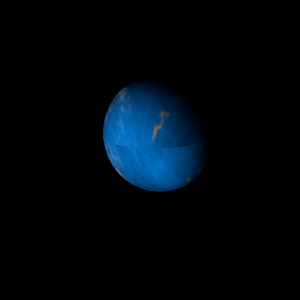|
|
Space Astro
|
Info for exoplanet "Gwei Zwengg"
| Scientific (actual) data |
|---|
| Name | Kepler-758 e |
| Planet status | Confirmed |
| Radius | 0.136 |
| Orbital period | 8.19347 |
| Discovered | 2016 |
| Updated | 2021-02-05 |
| Tconj | 2454970 |
| Publication | Announced on a website |
| Detection type | Primary Transit |
| Alternate names | 2MASS J19322030+4108075 e, K01060.04, KIC 5880320 e, KOI-1060 e, KOI-1060.04, WISE J193220.32+410807.5 e |
| Star name | Kepler-758 |
| Right ascension | 293.09° |
| Declination | 41.14° |
| Mag j | 13.37 |
| Mag h | 13.146 |
| Mag k | 13.11 |
| Star distance | 1353 |
| Star metallicity | -0.1 |
| Star mass | 1.16 |
| Star radius | 1.42 |
| Star age | 3.8 |
| Star temperature | 6228 |
| Star alternate names | 2MASS J19322030+4108075, KIC 5880320, KOI-1060, WISE J193220.32+410807.5 |
| Wikipedia article | Kepler-758 e |
Back
| |
| Fictional info (?) |
|---|
| Suggested name | Gwei Zwengg |
| Planet type | Cold planet |
| The smooth Borealis basin in the northern hemisphere covers 29 percent of the planet and may be a giant impact feature.
The two polar ice caps appear to be made largely of dust.
The outer atmosphere is visibly segregated into several bands at different latitudes, resulting in turbulence and storms along their interacting boundaries. |
| Atmosphere | Formaldehyde | 62% |
| Oxygen | 37% |
| Argon | 0.26% |
| Ethane | 0.14% |
| Atmospheric pressure | 100 bar |
 |
| Moon | Aimeng Houx-yong | Large almost round rocky asteroid |
| Wanf Yun | Very small potato shaped rocky moon |
| Aomwaizh-yaolwai | Small round gaseous comet |
| Wangbap | Very small slightly egg-shaped rocky asteroid |
| Fyonyao | Huge round oceanic asteroid |
| Fyush'erlwann | Huge round oceanic moon |
| Pyaot-anwwu | Huge round rocky comet |
| Yancyaq Angs | Very small round gaseous asteroid |
| Byao Qei | Small potato shaped crater-filled comet |
| Ougyue-lyun | Small almost round crater-filled asteroid |
| Yoyeng Jyue | Huge round rocky moon |
| Yancying-syun | Large almost round crater-filled moon |
| Anlyang | Huge potato shaped ice asteroid |
| Nyuezyao Shoj | Large irregular rocky comet |
| Kwang Xanq-you | Huge round rocky asteroid |
| Yuantwai Cweng | Large round rocky comet |
| Poucyot | Huge potato shaped gaseous asteroid |
| Wanroud | Very small round crater-filled planetoid |
| Chwan Ch | Small slightly egg-shaped rocky moon |
| Doujen Wyongr | Medium-sized potato shaped rocky moon |
| Yangx Ye | Small round rocky moon |
| Engye Dwogye-r | Large round gaseous comet |
| Yyuan Heng Zhyu | Medium-sized almost round gaseous planetoid |
| Yyowyue Fwengk | Small round crater-filled asteroid |
| Jwapyou | Huge slightly egg-shaped rocky asteroid |
| Chwei | Huge round ice moon |
| Ewyong-gye | Huge almost round rocky moon |
| Weibeng-zengy Wen | Very small irregular oceanic asteroid |
| Zwotweny | Large potato shaped rocky planetoid |
| Google search for Gwei zwengg |
|
Website by Joachim Michaelis
|
|
|
|